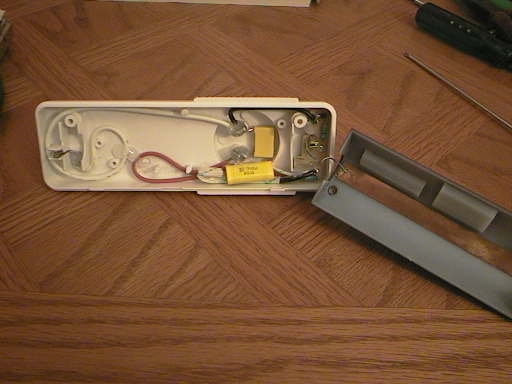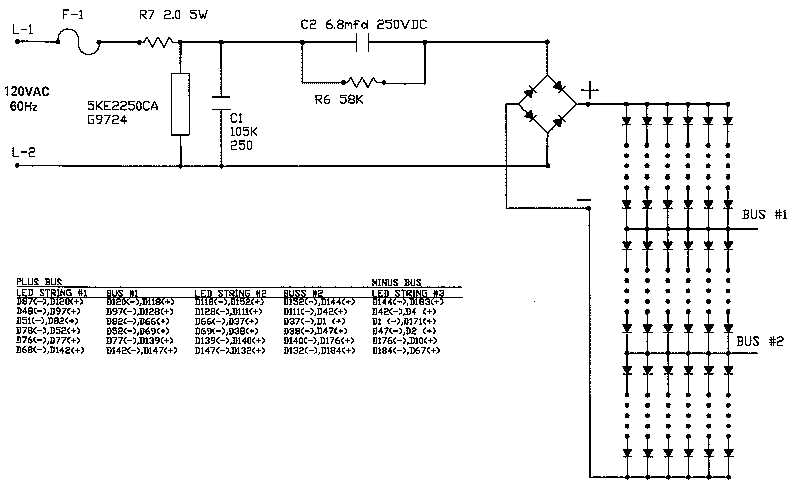[Back to Home Page]
www.RomanBlack.com
Super-cheap UV eraser 4w tube driver!
Drives a 4 watt fluoro tube from 240v AC with minimum parts.
Roman Black - April 2001
Warning!
All parts of this circuit operate at LETHAL VOLTAGES. Do not attempt
to build this or open up a commercial product like I did unless you are
totally competent and/or qualified to work on dangerous 240v AC mains
equipment!
Warning!
The ultra-violet light UVC tube as used in eprom erasers will make you
go blind and can cause cancer to skin cells. You must not expose yourself
to the UVC light, especially your eyes.
What is it?
This circuit is NOT my design, it is a review of the insides of a commercial
4 watt flourescent tube "night light" as sold in stores.
This circuit is a very cheap way to light up a 4 watt fluorescent tube
from 240v AC mains, and is totally suitable for a cheap home made
UV eprom eraser. All you need is the 4w UV tube and a few dollars
worth of parts, instead of paying $80+ USD for a commercial eprom eraser.
You could also buy a cheap 4 watt nightlight like I did and simply plug in
the UV tube and put it in a box!

How it works
C2 is used to limit the tube current once it is lit up and the tube resistance drops.
R1 is required by law to discharge C2 when the device is turned off.
C1 is required by law to reduce electrical noise from the device.
(I believe) D1 and R2 provide some DC bias to help the tube initially light up.
Copper foil strip is vital to get reliable tube start up (see photos).
Even a "dead" tube will work as long as the gas is ok. This is because the circuit
does NOT use the heater elements in the tube ends, (these elements usually fail
first when a tube is dead).
(I believe) the two 8-inch wire lengths (see photo) are required for noise suppression.
Inside the Night-Light
Below are 3 photos of the inside of the commercial product.
You can see the dull copper foil strip, and the yellow
capacitors. The 2 resistors and one diode were on a tiny
PCB, although with a circuit this simple a PCB is not
really needed.



UV eprom erasing
To erase an eprom or PIC micro (UV erasable J PIC) you need ultra-violet light type "C"
which is commonly called "UVC".
A normal 4w tube is type F4T5 (4 watt, 5 inch) and gives white light.
This is shown in the photos and mine was marked "F4T5D". These are about
$2 in stores.
To erase eproms you CANNOT use the cheap "UV blacklight" tubes which are
commonly available for use checking UV ink on documents and tickets etc.
The only tube that works is the short wavelength UVC tube, which emits the
dangerous light that causes materials to become unstable and makes humans
go blind. This tube is sold for "germicidal" use and is used in medical
sterilisation equipment to kill germs. Fortunately these hard to get UVC
tubes are sold in hobby electronics stores as replacements for their eprom
erasers. They are often expensive at about $18 USD but you will find cheaper
prices if you shop around the net.
The tube you need to erase chips is part G4T5 "Germicidal UVC"
and has clear glass.
If your UV tube has PURPLE glass it is NOT going to work for
erasing chips. These tubes are visible UV (for checking UV stamps on
money etc) and are a weak type of UV that is safer for humans. These
tubes can be marked U4T5 or similar.
Other circuits;
Florian Voelzke posted this circuit from a German 4w night-light
product, their mains voltage is 230v AC and the product uses the same
F4T5 tube although some parts values are different to the product I have.
Notice the German product has more noise filtering and more safety features
than the cheap Asian night-light I bought.

Richard Ottosen posted a circuit from a commercial LED traffic light,
this is a curious light that runs directly from 120v AC mains,
even though it is a semiconductor light using low-voltage LEDs. This is to
allow it to be a complete plug-in replacement for the incandescent spotlights
normally used in traffic lights. Very nifty, assuming the simple electronics
don't fail, this solid-state light "bulb" should last just about forever.
Also interesting is that the transformerless (capacitive reactance)
supply uses a 6.8uF capacitor,
this is the biggest i've seen and is a lot more current/power than normally
used in capacitive reactance supplies. I'm not sure what the total voltage/current
of the compound LED module is but I'm guessing about 150mA total.

- end -
[Back to Home Page]





